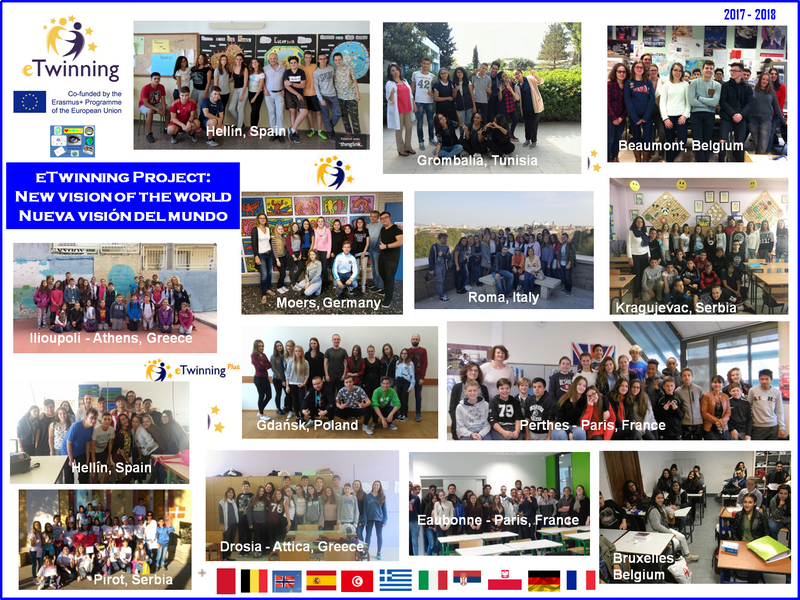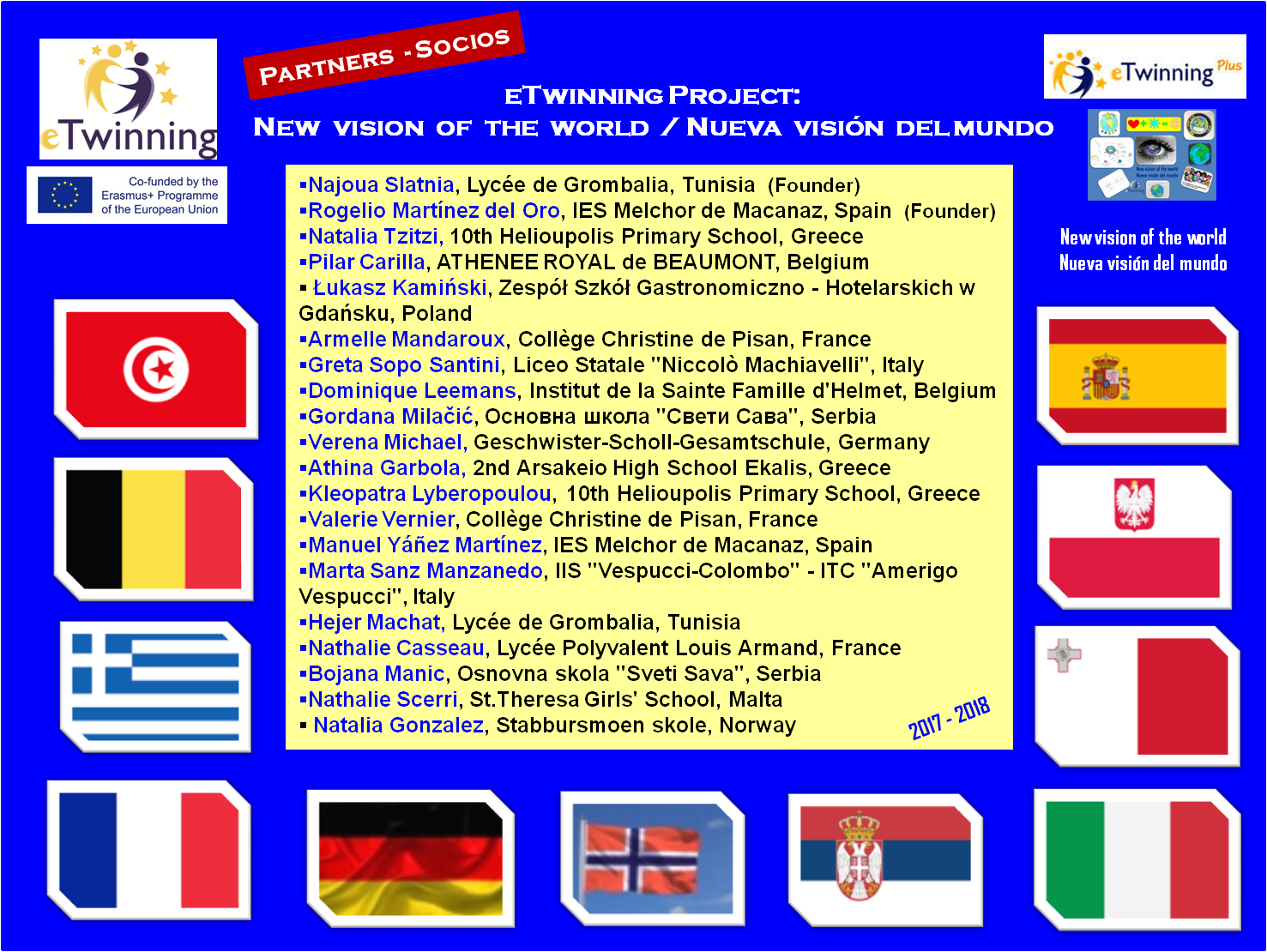Our project / Nuestro proyecto
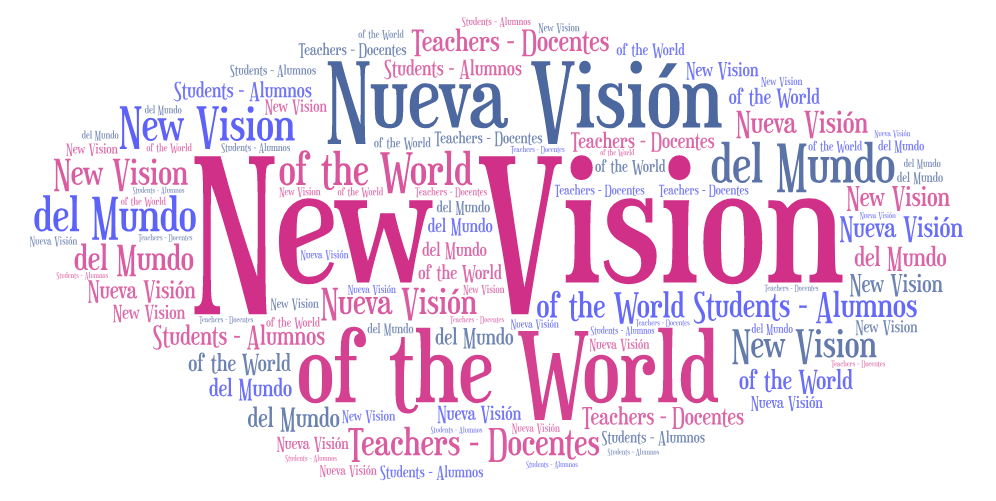
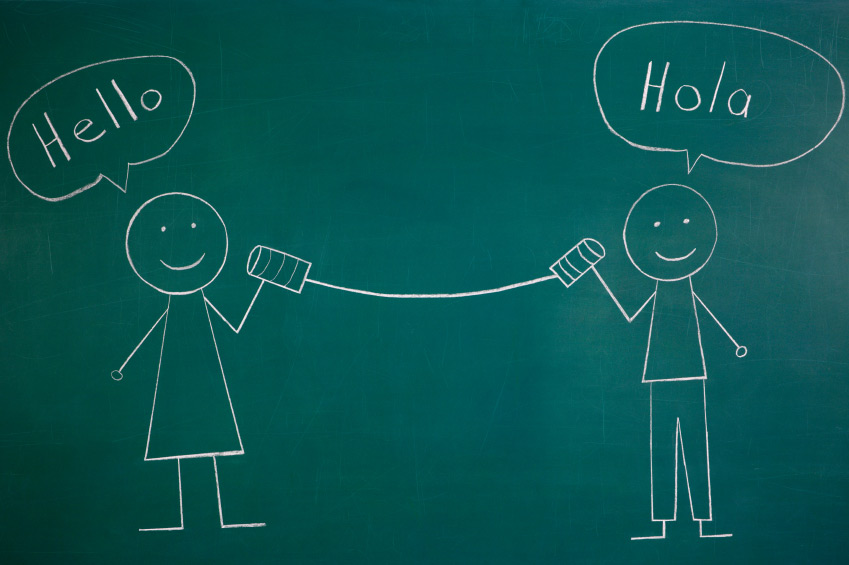
EN ENGLISH
Short description
Through creativity, collaboration, continuous communication, solidarity, responsibility and critical thinking... our students, in small and international groups, have formed a new vision of the world from an interdisciplinary perspective (science, technology, humanities, arts...). It is a bilingual, interdisciplinary and intercultural project in which our students have been the ambassadors of their cultures and heritage, the researchers, the creatives and the speakers. Our students have found an appropriate space to express their opinions for a new vision of Education.
The language of the project has not been any specific language. We have worked in both Spanish and English groups (including intercomprehension); improving our written and oral skills, our primary goal was communication. In a playful way we have approached the content and form, the best way perhaps to reach a new vision of the world.
We are partners from 11 countries: Tunisia – Spain – Belgium - Greece – Poland – Serbia – France – Italy – Germany - Malta - Norway
Founders: Najoua Slatnia ( Tunisia) @ Rogelio Martinez del Oro 5 Spain )
- To obtain a multidisciplinary formation.
- To practise the languages the writing and the oral one.
- To develop the different skills of the pupil, specially skills of the 21st century.
- To offer to the pupils the opportunity to collaborate in group and to be a Speaker and to face a hearing.
- To promote the Reflection, the critical thinking, the creativity and the Responsibility of pupils.
-...
PEDAGOGICAL INNOVATION AND CREATIVITY
We are looking at the world with different eyes.... From multiple perspectives or collaborative groups we wanted to raise awareness on topics previously chosen by the students themselves, such as the importance of languages, robotics, hunger in Africa, terrorism, climate change, water scarcity, music, Cultural Heritage, etc. Together we have produced presentations, e-books, magazines, comics, videos and games... with the ultimate aim of improving, detecting problems and finding solutions. A special Harmony between the different disciplines of the project (Science, Technology, Humanities, Arts) offered our students a complete formation to be an active, creative and responsible member in the society of the XXI century. A range of many countries, teachers and students have been able to coordinate, communicate, create... and conclude that a better world is possible. We have avoided the mere description of the exhibition and turned it into a game of research, collaboration and creativity. The students themselves were the discoverers, in small and mixed groups; they made the decisions themselves. Based on a script, they are the ones who have been outlining the project, helping each other to achieve their objectives. They have researched and developed it collaboratively and playfully. We have stressed the need to respect both copyrights (with brief advance instructions) and the need to respect each other among all project members (with a "charter" of good practices).The project has not only developed critical thinking in our students, but has also taught them to value their identities and cultural heritage while discovering and respecting the culture of their other partners. Finally, the evaluation reinforces our idea: the project has worked and our students have achieved true interdisciplinary learning. Our working language has been English and Spanish. Language has been our "instrument": we seek continuous communication, whatever the medium.
CURRICULAR INTEGRATION The whole project is part of our respective curricula. It is here that our project has its base; approaching them in a more playful, collaborative and international way has been our objective. The competence, the linguistic competence with English or Spanish as vehicular languages to the written and also to the oral one by means of videoconferences, the digital competence with the massive and intensive use of all kinds of tools both communicative and collaborative...all, one after the other, have had their inclusion in our project. Interdisciplinary learning has been very motivating for our students and has enriched their knowledge. Our students have improved in all the competitions. In "Learning to learn", for example, the students themselves have constructed their own materials and presentations. With a few short instructions they have created the activities and games that can be used by both Twinspace members and any internet user. Social and civic competence and European feeling and world citizens have also been at the heart of our work. We are all people, we have common characteristics and our own idiosyncrasies. Our students have had fun sharing their experiences with colleagues so far away, they have been able to see that they are not so different.... that we are children of the same civilization, the same way of understanding the world... The basic skills are assured in this project
COMMUNICATION AND EXCHANGE BETWEEN PARTNER SCHOOLS In order to carry out a project of this type, continuous communication between the teachers involved and between the students is essential. It is impossible to reach this point of collaboration without such continuous communication. Through multiple tools, teachers have been in continuous contact, concretizing, profiling, deciding and reaching consensus on each and every one of the different steps taken. Through Facebook, Adobe Connect, email, video conferencing with Zoom, Drive.... the teachers have been able to agree and coordinate the whole project. The high availability of all members for this communication should be stressed. Some examples can be seen in Twinspace. Students have come into contact from the forums to Chat Twinspace, Drive or Padlet and other Web 2.0 tools when we set up the small (and mixed) groups, and of course with the videoconferences with Adobe connect, recorded and displayed on Twinspace.
COLLABORATION BETWEEN PARTNER SCHOOLS.
In this project, each teacher has been the referent and coordinator of their national group. The previous consensus needed was that we really were only one teacher sending the same message, each one to his or her group. We have communicated the same guidelines; to this end, communication has been continuous and detailed to the extreme.
Through videoconferences, e-mails, facebook... we discussed and agreed on the activities and themes and the 8 international groups. Almost all of the partner teachers participated in the organization of the Twinspace of our project (creation of pages, sub-pages...etc), creation of links to tools for collaborative activities, publication of final products. Each teacher is also responsible for monitoring the work of one of the 8 interdisciplinary and international groups (at https://twinspace.etwinning.net/44714/pages/page/339832 or https://twinspace.etwinning.net/44714/pages/page/262814 ).
Thanks to the tools used, it has been easy to keep in contact with students. Our goal is that all activities had to be collaborative. Only from this prism could we consider that these would have value in themselves. Collaborative was the creation of a single logo (google paint), the final products of the 8 international groups (ebooks, magazines, presentations, etc.), the creation of the magazine Patrimonio Cultural, the video of our native languages, the cultural kahoots, the presentation of the Safer Internet Day, the ebook of the New Vision of Education....
Parallel activities such as personal/institute presentations, the eTwinning Day celebration and other events can be interesting at certain times, but the important thing is that our students knew about the partner's work and could complement each other, not just by joining forces.
The final result has surprised us. When our students are given freedom of action, the results can be very surprising....
USE OF TECHNOLOGY
One of the cardinal points of our project has been the use (the good use) of technology. We have used multiple and varied tools (already mentioned in previous sections)
- Padlet for presentations between students, presentation of their schools and publications on the cultural heritage of partner countries.
- Google paint for the creation of the collaborative logo
- Vivavideo, filmmaker..biteable and movie maker for the creation of the videos ( about our centres, countries etc)
- Google forms to choose your own working group and also for the evaluation of the project.
- Forums and Chat Twinspace and to introduce yourself, discuss the project topics, prepare the cultural questionnaire.
- Kahoot to create the cultural kahoot about our countries
- Google slides to carry out its collaborative activities of the 8 groups and the activity of the safer internet day.
- Google doc to collaborate and express its vision of education.
- Calameo, Issu, Joomag to publish ebooks and magazines.
- Prezzi, Sway, Genially To make presentations.
- Other web 2.0 tools
- Adobe connect, hangout and zoom for video conferencing.
- etc
The result is our interesting final collaborative products...and the satisfaction of seeing the high degree of involvement of our students.
And we have tried to do everything taking as reference and base of our project the Twinspace platform, for its simplicity and security.
RESULTS, IMPACT AND DOCUMENTATION
Every eTwinning project has an immediate effect on students. The notion of collaboration, Europeanism and world citizenship, ICT, respect and/or intercomprehension has permeated our students. We are not independent and different entities.
Interdisciplinarity, critical thinking, responsibility and appreciation of cultural heritage are among the most important achievements of this project.
The Safer Internet Day celebration, organised by the members of this project, has been very beneficial for the school's students and has had a very positive impact on our school.
On the other hand, our centres test every year the need to implement these project-based learning methods. The degree of satisfaction it generates is very high among the students and its results speak for themselves. This is why we encourage their development from the management of our centres.
All the documentation is developed in Twinspace or made with other tools but embedded in the platform.
One of the most important points of the project is to give greater visibility to the work carried out: it is satisfactory not only to carry out the work but also to make it known. So we have organized a series of conferences to disseminate the project's results to parents, the rest of the educational community in our schools and to give our students the opportunity to be speakers and face the audience. https://twinspace.etwinning.net/44714/pages/page/398276
EN ESPAÑOL
Breve descripción
Mediante la creatividad, la colaboración, la comunicación continúa, la solidaridad, la responsabilidad y el pensamiento crítico… nuestros alumnos, en grupos reducidos e internacionales, han formado una nueva visión del mundo desde una perspectiva interdisciplinar (ciencia, tecnología, humanidades, artes…). Es un proyecto bilingüe, interdisciplinario e intercultural en lo cual nuestros alumnos han sido los embajadores de sus culturas y sus patrimonios, los investigadores, los creativos y los ponentes. Nuestros alumnos han encontrado un espacio apropiado para expresar sus opiniones para una nueva visión de la Educación.
La lengua vehicular del proyecto no ha sido ninguna en concreto. Hemos trabajado tanto grupos en español como en inglés (incluso la intercomprensión); mejorando la competencia escrita y oral, nuestro objetivo primero era la comunicación. De una forma lúdica hemos abordado el contenido y la forma, el mejor camino quizás para alcanzar una nueva visión del mundo.
Somos socios de 11 países: Túnez - España - Bélgica - Grecia - Polonia - Serbia - Francia - Italia - Alemania - Malta – Noruega
Fundadores: Najoua Slatnia (Túnez) @ Rogelio Martinez del Oro (España)
OBJETIVOS:
- Obtener una formación pluridisciplinaria.
- Practicar las lenguas al escrito y al oral.
- Desarrollar las diferentes competencias del alumnado, especialmente las competencias del siglo 21.
- Ofrecer al alumnado la oportunidad de colaborar en grupo y de ser ponente ( speaker) y de enfrentar una audiencia.
- Fomentar la Reflexión, la creatividad y la Responsabilidad del alumnado.
INNOVACIÓN PEDAGÓGICA Y CREATIVIDAD
Miremos al Mundo con otros ojos… Desde múltiples perspectivas o grupos colaborativos hemos querido sensibilizarnos sobre temas elegidos previamente por los propios alumnos tales como la importancia de las lenguas, la Robótica, el hambre en África, el terrorismo, el cambio climático, la escasez del agua, la música, el Patrimonio Cultural. etc.
De forma conjunta hemos producido presentaciones, e-books, revistas, cómic, vídeos y juegos… con el objetivo final de mejorar, de detectar problemas y encontrar soluciones. Una especial Armonía entre las diferentes disciplinas del proyecto (Ciencia, Tecnología, Humanidades, Artes) ofreció a nuestros estudiantes una formación completa para ser un miembro activo, creativo y responsable en la sociedad del siglo XXI.
Un abanico de muchos países, profesores y alumnos hemos sido capaces de coordinarnos, comunicarnos, crear… y concluir que un Mundo mejor es posible.
Hemos huido de la mera descripción expositiva y convertirlo en un juego de investigación, colaboración y creatividad. Los propios alumnos han sido los descubridores, por grupos reducidos y mixtos; ellos mismos tomaron las decisiones. A partir de un guión son ellos los que han ido perfilando el proyecto, ayudándose mutuamente para alcanzar sus objetivos. Han investigado y lo han elaborado colaborativa y lúdicamente.
Hemos incidido en la necesidad de respetar tanto derechos de autor (con unas breves instrucciones previas) como de respetarse mutuamente entre todos los miembros del proyecto (con una "carta" de buenas prácticas).
El proyecto no sólo ha desarrollado el pensamiento crítico en nuestros alumnos, sino que también les ha enseñado a valorar sus identidades y su patrimonio cultural a la vez que descubren y respetan la cultura de sus otros socios.
Finalmente, la evaluación nos afianza en nuestra idea: el proyecto ha funcionado y nuestros alumnos han conseguido un verdadero aprendizaje interdisciplinario.
Nuestra lengua vehicular ha sido el inglés y el español. La lengua ha sido nuestro “instrumento”: buscamos la comunicación continua, fuera con el medio que fuera.
INTEGRACIÓN EN EL PLAN DE ESTUDIOS
Todo el proyecto se enmarca en nuestros respectivos currículos. Es aquí donde nuestro proyecto tiene su base; el abordarlos de una forma más lúdica, colaborativa e internacional ha sido nuestro objetivo.
La competencia, la competencia lingüística con el inglés o el español como lenguas vehiculares al escrito y también al oral mediante videoconferencias, la competencia digital con el uso masivo e intensivo de todo tipo de herramientas tanto comunicativas como colaborativas...todas, una tras otra, han tenido su inclusión en nuestro proyecto. El aprendizaje interdisciplinario ha sido muy motivador para nuestros alumnos y ha enriquecido sus conocimientos. Nuestros alumnos han mejorado en todas las competencias. En “Aprender a aprender”,por ejemplo, los mismos alumnos han construido sus materiales y presentaciones. Con unas pequeñas instrucciones han realizado las actividades y juegos que pueden ser utilizados tanto por los miembros del Twinspace como por cualquier usuario de internet.
La competencia social y cívica y sentimiento europeo y ciudadanos del mundo también ha sido eje de nuestro trabajo. Todos somos personas, tenemos características comunes y nuestra propia idiosincrasia. Nuestros alumnos se han divertido compartiendo con compañeros tan lejanos sus experiencias, han podido comprobar que no son tan diferentes... que somos hijos de la misma civilización, de la misma forma de entender el mundo…
Las competencias básicas están aseguradas en este proyecto
COMUNICACIÓN E INTERACCIÓN ENTRE CENTROS SOCIOS
Para llevar a cabo un proyecto de este tipo es imprescindible una continua comunicación tanto entre los profesores implicados como entre los alumnos. Es imposible llegar a este punto de colaboración si no existe esa comunicación continua.
Mediante múltiples herramientas, los profesores hemos estado en contacto continuo, concretando, perfilando, decidiendo y consensuando todos y cada uno de los diferentes pasos dados. Mediante Facebook, Adobe Connect, correo, videoconferencia con Zoom, Drive... los profesores hemos podido consensuar y coordinar todo el proyecto. Ha de remarcar la alta disponibilidad de todos los integrantes para esta comunicación. Pueden verse algunos ejemplos en Twinspace.
Los alumnos han entrado en contacto desde los foros hasta Chat Twinspace, Drive o Padlet y otras herramientas del Web 2.0 cuando establecimos los grupos reducidos (y mixtos), y por supuesto con las videoconferencias con Adobe connect, grabadas y expuestas en Twinspace.
COLABORACIÓN ENTRE CENTROS ESCOLARES ASOCIADOS
En este proyecto, cada profesor ha sido el referente y coordinador de su grupo nacional. El consenso previo necesario hacía que realmente fuésemos un solo profesor emitiendo el mismo mensaje, cada uno a su grupo. Hemos comunicado las mismas directrices; para ello, la comunicación ha sido continua y detallada hasta el extremo.
A través de videoconferencias, correos, facebook... discutimos y acordamos las actividades y temas y los 8 grupos internacionales. Casi todos los profesores socios participaron en la organización del Twinspace de nuestro proyecto (creación de páginas, subpáginas...etc), creación de enlaces de herramientas para actividades colaborativas, publicación de productos finales. Cada profesor también se encarga del seguimiento del trabajo de uno de los 8 grupos interdisciplinarios e internacionales. (en https://twinspace.etwinning.net/44714/pages/page/339832 o https://twinspace.etwinning.net/44714/pages/page/262814 ).
Gracias a las herramientas utilizadas ha sido fácil el mantener en contacto alumno con alumno. Nuestro objetivo es que todas las actividades tenían que ser colaborativas. Solo desde este prisma podíamos considerar que estas tendrían valor en sí. Colaborativo fue la creación de un único logotipo (google paint), los productos finales de los 8 grupos internacionales (ebooks, revistas, presentaciones, etc.), la creación de la revista Patrimonio Cultural, el vídeo de nuestras lenguas nativas, los kahoots culturales, la presentación del Día para una Internet más segura,el ebook de la Nueva Visión de la Educación...
Actividades paralelas como las presentaciones personales/instituto, la celebración del Día eTwinning y otros eventos pueden ser interesantes en determinados momentos, pero lo importante es que nuestros alumnos supieran del trabajo del socio y pudieran complementarse juntos, no solamente sumando esfuerzos.
El resultado final nos ha sorprendido. Cuando a nuestros alumnos se les da libertad de acción, los resultados pueden ser muy sorprendentes…
USO DE LA TECNOLOGÍA
Uno de los puntos cardinales de nuestro proyecto ha sido el uso (el buen uso) de la tecnología. Hemos utilizado múltiples y variadas herramientas (ya comentadas en apartados anteriores)
- Padlet para las presentaciones entre los alumnos, la presentación de sus centros y las publicaciones sobre el patrimonio cultural de los países socios.
- Google paint para la creación del logo colaborativo
- Vivavideo, filmora..biteable y movie maker para la creación de los videos ( sobre nuestros centros, paises etc)
- Google forms para elegir cada uno su grupo de trabajo y también para la evaluación del proyecto.
- Foros y Chat Twinspace y para presentarse, discutir los temas del proyecto, preparar el cuestionario cultural.
- Kahoot para crear el kahoot cultural sobre nuestros países
- Google slides para realizar sus actividades colaborativas de los 8 grupos y de la actividad del safer internet day.
- Google doc para colaborar y expresar su visión de la educación.
- Calameo, Issu, Joomag para publicar ebooks y revistas.
- Prezzi, Sway, Genially Para hacer presentaciones.
- Otras herramientas web 2.0
- Adobe connect, hangout y zoom para hacer videoconferencias.
- etc
El resultado son nuestros interesantes productos colaborativos finales...y la satisfacción de comprobar el altísimo grado de implicación de nuestros alumnos.
Y todo lo hemos intentado hacer tomando como referencia y base de nuestro proyecto la plataforma Twinspace, por su grado de simplicidad y seguridad.
Por último, aunque esto sólo desde el lado español, hemos hecho uso de Classroom de Google como medio organizador del proyecto. Puede accederse con el nombre de usuario indicado al principio de esta memoria.
RESULTADOS, IMPACTO Y DOCUMENTACIÓN
Todo proyecto eTwinning tiene un efecto inmediato en los alumnos. La noción de colaboración, europeísmo y ciudadano del mundo, TIC, respeto y/o intercomprensión ha calado en nuestros alumnos. No somos entes independientes y diferentes.
La interdisciplinariedad, el pensamiento crítico, la responsabilidad y la valorización del patrimonio cultural son de los logros más importantes de este proyecto.
La celebración del Día de internet más Segura, organizada por los miembros de este proyecto ha sido muy beneficioso para los alumnos del centro y de impacto muy positivo en nuestro centro
Por otro lado, nuestros centros comprueban cada año de la necesidad de implementar estos métodos de aprendizaje basado en proyectos. El grado de satisfacción que genera es muy alto entre los alumnos y sus resultados hablan por sí solos. Es por ello por lo que se favorece su desarrollo desde la dirección de nuestros centros.
Toda la documentación está desarrollada en Twinspace o realizada con otras herramientas pero incrustadas en la plataforma. Sólo hemos utilizado Classroom de Google como instrumento organizativo (por parte española) como herramienta ajena al Twinspace.
Uno de los puntos más importantes del proyecto es dar mayor visibilidad al trabajo realizado: es satisfactorio no sólo realizar el trabajo sino que se conozca. Así que hemos organizado unas conferencias de difusión del proyecto para comunicar los resultados a los padres, al resto de la comunidad educativa de nuestros centros y para dar la oportunidad a nuestros alumnos del proyecto para ser ponentes y enfrentar la audiencia. https://twinspace.etwinning.net/44714/pages/page/398276
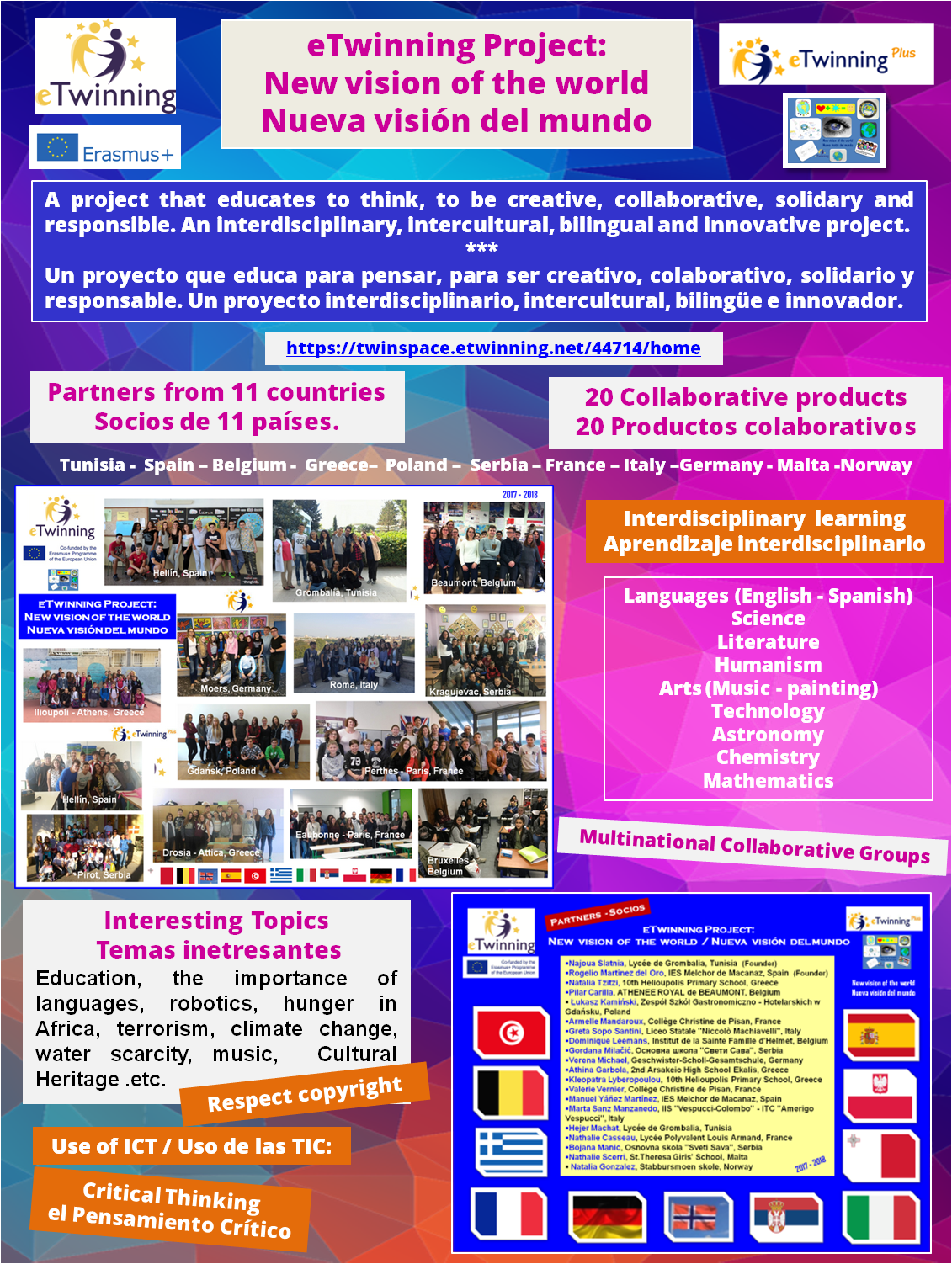
Video link / enlace del video
https://biteable.com/watch/project-new-vision-of-the-world-1681795
Project New vision of the world on Biteable.
